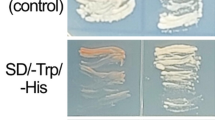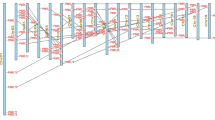Abstract
A partial cDNA which codes for the β-subunit of a plastidic chaperonin 60 (cpn60-β) from rye (Secale cereale L.) leaves was identified and sequenced, except for 46 amino acids of the N-terminus of the mature protein and the transit sequence. This is the first cpn60-β sequence determined for a monocotyledonous plant. Specific antibodies against cpn60-β were affinity-purified from an antiserum raised against the total soluble protein fraction of ribosome-deficient plastids. The localization of cpn60-β in chloroplasts or non-green plastids was confirmed by immunodetection in Percoll gradient-purified organelles. The expression and occurrence of cpn60-β was analysed by immunoblotting with the specific antibodies and Northern hybridization. The cpn60-β protein was constitutively expressed in various green and non-green tissues. It was evenly distributed along the major part of a rye leaf, while highest transcript levels occurred in the youngest and oldest leaf sections. The expression of the cpn60-β protein was not enhanced by a heat-shock treatment at 42 °C. The cpn60-β transcript and protein were more strongly expressed in various non-green, for instance etiolated, 70S-ribosome-deficient 32 °C-grown, or herbicide-bleached tissues, than in green leaves of rye. A rapid increase in the cpn60-β transcript level was also observed when green leaves were transferred from light to darkness while the protein level was not affected. The dark-induced increase in the cpn60-β transcript was totally suppressed in the presence of 2% sucrose. Inhibitor treatments suggested that the change in cpn60-β transcript level was not related to changes of the ATP supply of the tissue. While the large subunit of the photosynthetic protein ribulose-1,5-bisphosphate carboxylase was largely degraded during ripening of tomato fruits, high levels of cpn60-β were detected in tomato chromoplasts and in the yellow flower petals of Narcissus. Low levels of cpn60-β were detected in root tissue.
Similar content being viewed by others
Abbreviations
- cpn60:
-
chaperonin 60
- HSP:
-
heat shock protein
- Rubisco:
-
ribulose-1,5-bisphosphate carboxylase/oxygenase
References
Baneyx F, Bertsch U, Kalbach CE, van der Vies SM, Soll J, Gatenby AA (1995) Spinach chloroplast cpn21 co-chaperonin possesses two functional domains fused together in a toroidal structure and exhibits nucleotide-dependent binding to plastid chaperonin 60. J Biol Chem 270: 10695–10702
Berberich T, Feierabend J (1994) The onset of 70S chloroplast ribosome formation is determined by an early heat-sensitive stage in the ontogeny of rye leaves. Plant Cell Physiol 35: 907–916
Bertsch U, Soll J, Seetharam R, Viitanen PV (1992) Identification, characterization, and DNA sequence of a functional “double” groES-like chaperonin from chloroplasts of higher plants. Proc Natl Acad Sci USA 89: 8696–8700
Chen GG, Jagendorf AT (1994) Chloroplast molecular chaperonessisted refolding and reconstitution of an active multisubmit coupling factor CF1 core. Proc Natl Acad Sci USA 91: 11497–11501
Cheng MY, Hartl F-U, Martin J, Pollock RA, Kalousek F, Neupert W, Hallberg RL, Horwich AL (1989) Mitochondrial heat-shock protein hsp60 is essential for assembly of proteins imported into yeast mitochondria. Nature 337: 620–625
Cloney LP, Wu HB, Hemmingsen SM (1992a) Expression of plant chaperonin-60 genes in Escherichia coli. J Biol Chem 267: 23327–23332
Cloney LP, Bekkaoui DR, Wood MG, Hemmingsen SM (1992b) Assessment of plant chaperonin-60 gene function in Escherichia coli. J Biol Chem 267: 23333–23336
Cohen Y, Yalovsky S, Nechushtai R (1995) Integration and assembly of photosynthetic protein complexes in chloroplast thylakoid membranes. Biochim Biophys Acta 1241: 1–30
Dahlin C, Cline K (1991) Developmental regulation of the plastid protein import apparatus. Plant Cell 3: 1131–1140
Ehmann B, Kranz M, Mummert E, Schäfer E (1993) Two Tcp-1related but highly divergent gene families exist in oat encoding proteins of assumed chaperone function. FEBS Lett 336: 313–316
Feierabend J (1982) Inhibition of chloroplast ribosome formation by heat in higher plants. In: Edelman M, Hallick RB, Chua N-H (eds) Methods in chloroplast molecular biology. Elsevier Biomedical Press, pp 671–680
Feierabend J, Berberich T (1991) Heat-induced ribosome-deficiency of plastids — mechanism and applications. In: Mache R, Stutz E, Subramanian AR (eds) The translational apparatus of photosynthetic organelles. Springer, Berlin, Heidelberg, New York, pp 215–227
Feierabend J, Winkelhüsener T, Kemmerich P, Schulz U (1982) Mechanism of bleaching in leaves treated with chlorosis-inducing herbicides. Z Naturforsch 37c: 898–907
Feierabend J, Schlüter W, Tebartz K (1988) Unassembled polypeptides of the plastidic ribosomes in heat-treated 70S ribosome deficient rye leaves. Planta 174: 542–550
Feinberg AP, Vogelstein B (1983) A technique for radiolabeling DNA restriction endonuclease fragments to high specific activity. Anal Biochem 132: 6–13
Gatenby AA, Ellis RJ (1990) Chaperone function: The assembly of ribulose bisphosphate carboxylase-oxygenase. Annu Rev Cell Biol 6: 125–149
Gatenby AA, Viitanen PV (1994) Structural and functional aspects of chaperonin-mediated protein folding. Annu Rev Plant Physiol Plant Mol Biol 45: 469–491
Gerhardt B, Beevers H (1968) Influence of sucrose on protein determination by the Lowry procedure. Anal Biochem 24: 337–339
Gray JC, Row PE (1995) Protein translocation across chloroplast envelope membranes. Trends Cell Biol 5: 243–247
Grimm R, Speth V, Gatenby AA, Schäfer E (1991) GroEL-related molecular chaperones are present in the cytosol of oat cells. FEBS Lett 286: 155–158
Hartl F-U, Hlodan R, Langer T (1994) Molecular chaperones in protein folding: the art of avoiding sticky situations. Trends Biol Sci 19: 20–25
Hemmingsen SM, Wooford CA, van der Vies SM, Tilly K, Dennis DT, Georgopoulos CP, Hendrix RW, Ellis RJ (1988) Homologous plant and bacterial proteins chaperone oligomeric protein assembly. Nature 333: 330–334
Hendrick JP, Hartl F-U (1993) Molecular chaperone functions of heat-shock proteins. Annu Rev Biochem 62: 349–84
Höinghaus R, Feierabend J (1983) Rapid purification of intact chloroplasts and heat-bleached ribosome-deficient plastids from rye leaves on discontinuous Percoll gradients. Protoplasma 118: 114–120
Jakob U, Buchner J (1994) Assisting spontaneity: the role of HSP90 and small HSPs as molecular chaperones. Trends Biol Sci 19: 205–211
Jang J-C, Sheen J (1994) Sugar sensing in higher plants. Plant Cell 6: 1665–1679
Kim S-R, Costa MA, An G (1991) Sugar response element enhances wound response of potato proteinase inhibitor II promoter in transgenic tobacco. Plant Mol Biol 17: 973–983
Koning AJ, Rose R, Comai L (1992) Developmental expression of tomato heat-shock cognate protein 80. Plant Physiol 100: 801–811
Krishna P, Sacco M, Cherutti JF, Hill S (1995) Cold-induced accumulation of hsp90 transcripts in Brassica napus. Plant Physiol 107: 915–923
Kruse E, Liu Z, Kloppstech K (1993) Expression of heat shock proteins during development of barley. Plant Mol Biol 23: 111–122
Kyhse-Andersen J (1984) Electroblotting of multiple gels: A simple apparatus without buffer tank for rapid transfer of proteins from polyacrylamide to nitrocellulose. J Biochem Biophys Methods 10: 203–209
Laemmli UK (1970) Cleavage of structural proteins during the assembly of the head of bacteriophage T4. Nature 227: 680–685
Lam H-M, Peng S-Y, Coruzzi GM (1994) Metabolic regulation of the gene encoding glutamine-dependent asparagine synthetase in Arabidopsis thaliana. Plant Physiol 106: 1347–1357
Logemann J, Schell J, Willmitzer L (1987) Improved method for the isolation of RNA from plant tissues. Anal Biochem 163: 16–20
Lubben TH, Donaldson GK, Viitanen PV, Gatenby AA (1989) Several proteins imported into chloroplasts form stable complexes with the GroEL-related chloroplast molecular chaperone. Plant Cell 1: 1223–1230
Marshall JS, Keegstra K (1992) Isolation and characterization of a cDNA clone encoding the major HSP70 of the pea chloroplastic stroma. Plant Physiol 100: 1048–1054
Marshall JS, DeRocher AE, Keegstra K, Vierling E (1990) Identification of heat shock protein hsp70 homologues in chloroplasts. Proc Natl Acad Sci USA 87: 374–378
Martel R, Cloney LP, Pelcher LE, Hemmingsen SM (1990) Unique composition of plastid chaperonin-60: α and β polypeptide encoding genes are highly divergent. Gene 94: 181–187
Mori M, Murata K, Kubota H, Yamamoto A, Matsushiro A, Morita T (1992) Cloning of a cDNA encoding the Tcp-1 (t complex polypeptide 1) homologue of Arabidopsis thaliana. Gene 122: 381–382
Nover L (1991) Heat shock response. CRC Press, Boca Raton, Ann Arbor, Boston, London
Otto S, Feierabend J (1989) Enzymes of starch and sugar phosphate metabolism in achlorophyllous ribosome-deficient plastids from high-temperature-grown rye leaves. Physiol Plant 76: 65–73
Prasad TK, Stewart CR (1992) cDNA clones encoding Arabidopsis thaliana and Zea mays mitochondrial chaperonin HSP60 and gene expression during seed germination and heat shock. Plant Mol Biol 18: 873–885
Reiß T, Bergfeld R, Link G, Thien W, Mohr H (1983) Photooxidative destruction of chloroplasts and its consequences for cytosolic enzyme levels and plant development. Planta 159: 518–528
Sambrook J, Fritsch EF, Maniatis T (1989) Molecular cloning, a laboratory manual. Cold Spring Harbor Lab Press, Cold Spring Harbor, New York
Sanger F, Nicklen S, Coulson AR (1977) DNA sequencing with chain-terminating inhibitors. Proc Natl Acad Sci USA 74: 5463–5467
Schmidt M, Svendsen I, Feierabend J (1995) Analysis of the primary structure of the chloroplast isozyme of triosephosphate isomerase from rye leaves by protein and cDNA sequencing indicates a eukaryotic origin of its gene. Biochim Biophys Acta 1261: 257–264
Schmitz G, Schmidt M, Feierabend J (1996) Characterization of a plastid-specific HSP90 homologue: Identification of a cDNA sequence, phylogenetic descendence and analysis of its mRNA and protein expression. Plant Mol Biol 30: 479–492
Takahashi T, Naito S, Komeda Y (1991) Isolation and analysis of the expression of two genes for the 81 kilodalton heat-shock proteins from Arabidopsis. Plant Physiol 99: 383–390
Thompson MD, Paavola CD, Lenvik TR, Gantt JS (1995) Chlamydomonas transcripts encoding three divergent plastid chaperonins are heat-inducible. Plant Mol Biol 27: 1031–1035
Towbin H, Staehelin T, Gordon J (1979) Electrophoretic transfer of proteins from polyacrylamide gels to nitrocellulose sheets: procedure and some applications. Proc Natl Acad Sci USA 76: 4350–4354
Tseng T-C, Tsai T-H, Lue M-Y, Lee H (1995) Identification of sucrose-regulated genes in cultured rice cells using mRNA differential display. Gene 161: 179–182
Tsugeki R, Mori H, Nishimura M (1992) Purification, cDNA cloning and Northern-blot analysis of mitochondrial chaperonin 60 from pumpkin cotyledons. Eur J Biochem 209: 453–458
Vierling E (1991) The roles of heat shock proteins in plants. Annu Rev Plant Physiol Plant Mol Biol 42: 579–620
Waegemann K, Soll J (1991) Characterization of the protein import apparatus in isolated outer envelopes of chloroplasts. Plant J 1: 149–158
Winter U, Feierabend J (1990) Multiple coordinate controls contribute to a balanced expression of ribulose-1,5-bisphosphate carboxylase/oxygenase subunits in rye leaves. Eur J Biochem 187: 445–453
Yost HJ, Lindquist S (1986) RNA splicing is interrupted by heat shock and is rescued by heat shock protein synthesis. Cell 45: 185–193
Zabaleta E, Oropeza A, Jiménez B, Salerno G, Crespi M, Herrera-Estrella L (1992) Isolation and characterization of genes encoding chaperonin 60β from Arabidopsis thaliana. Gene 111: 175–181
Zabaleta E, Oropeza A, Assad N, Mandel A, Salerno G, Herrera-Estrella L (1994) Antisense expression of chaperonin 60β in transgenic tobacco plants leads to abnormal phenotypes and altered distribution of photoassimilates. Plant J 6: 425–432
Author information
Authors and Affiliations
Corresponding author
Additional information
Financial support by the Fonds der Chemischen Industrie, Germany, is greatly appreciated.
Rights and permissions
About this article
Cite this article
Schmitz, G., Schmidt, M. & Feierabend, J. Comparison of the expression of a plastidic chaperonin 60 in different plant tissues and under photosynthetic and non-photosynthetic conditions. Planta 200, 326–334 (1996). https://doi.org/10.1007/BF00200300
Received:
Accepted:
Issue Date:
DOI: https://doi.org/10.1007/BF00200300




